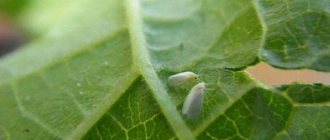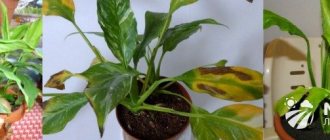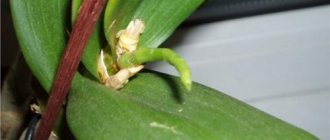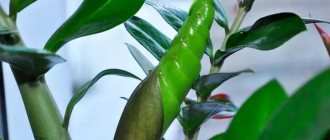All plants, no matter where they are grown, are subject to invasion by various pests. In addition, indoor plants that housewives love to grow are susceptible to various diseases and the harmful effects of various insects. Various reasons contribute to this. Often housewives themselves are to blame for this, since they do not create the proper conditions for growth and development for plants. Some of them simply forget to water the plants, and some of them water them excessively. It should be noted that there are quite dangerous pests that can reduce a person’s work to zero.
As a result of the appearance of pests, indoor plants lag behind in development and lose their attractiveness, and often even die. Therefore, the main task of indoor plant lovers is the timely detection of parasites and subsequent control of them. This article talks about the main pests of indoor plants, their appearance, as well as ways to combat them.
Whitefly
This is an insect with a body length of no more than 2 mm. A characteristic feature is white wings and a yellowish body. They can be found:
- On the back side of the leaves, where they are located in colonies.
- According to characteristic sweetish traces, on which after some time a sooty fungus appears.
Whitefly larvae have a sucking type of mouthparts, so they suck out the juices from the plant. As a result, the plant loses its vitality and gradually loses its attractiveness. If no measures are taken, the plant will soon die.
Interesting fact! When appearing in greenhouses, the whitefly prefers plants such as hibiscus, pelargonium or begonia. After the appearance of just one individual, after a short period of time a whole colony of these insatiable pests appears in the greenhouse. In this regard, the fight should begin immediately.
Saving indoor plants from pests and diseases - Everything will be fine - Issue 282 - 11/05/2013
How to prevent it from appearing
Actions related to the fight against whitefly should begin in the fall, immediately after harvest. To do this, you need to completely remove plant debris from the greenhouse. This way you will reduce the likelihood of the pest getting into the ground, where it can easily overwinter and wait until spring.
In the spring, at the seedling propagation stage, do not place seedlings next to home crops. The whitefly loves geraniums and pelargonium, from where it moves to young shoots, and with them ends up in the greenhouse. Therefore, try to ensure that indoor flowers and seedlings of tomatoes, cucumbers, and peppers are located on different windowsills.
Aphid
These are also harmful insects that suck juices from plants due to the presence of piercing-sucking mouthparts. Insects have an ovoid body shape, no more than 2 mm in length. Aphids have rather long legs, but they move rather slowly. The color of insects depends on the species, as well as on living conditions, so it can be varied.
There are both winged and wingless types of insects. Naturally, insects with wings can easily enter a person’s home, even through an open window.
Hairy aphid
This type of aphid is also called mealybugs. They are one of the most dangerous insects for plants. As a rule, they can be found on the underside of leaves. Their presence is indicated by a cobweb-like white coating, as well as the presence of a sticky liquid.
These insects are distinguished by a high degree of fertility. Female mealybugs lay eggs in miniature formations that resemble balls of cotton wool. After a certain time, fairly mobile larvae emerge from these lumps, which are then distributed throughout the plant. Fighting them requires an instant reaction. The sooner you start fighting this pest, the greater the chance of saving the plant.
Mealybug is a pest of domestic flowers. Signs of infection, methods of control
Chemicals for mealybugs
If traditional methods are ineffective or there are large foci of infection, you have to turn to chemical insecticides.
Widely available effective drugs against mealybug:
- "Decis".
- "Vertimek".
- "Tsvetofos".
- "Nurell D."
- "Phosfamide."
- "Bi-58".
- "Aktellik".
- "Fitoverm".
- "Aplaud."
There should not be any particular difficulties with such substances. The main thing is to read the instructions carefully and follow all safety precautions.
Affected plants must be quarantined. Usually 3-4 insecticide treatments are sufficient. If pests still remain, you need to change the product.
Root mealybug
This type of pest poses the main threat to the root system of plants. The parasite can be detected either in the ground or on the lower part of the plant stems, by a whitish coating. Females reach a length of up to 2.5 mm, while they are larger than males and much more mobile. Pests are distinguished by their almost cylindrical body shape, covered with a waxy coating. Females lay eggs in special chambers formed by special secretions.
Males are more like whiteflies. As adults, they quickly die because they stop feeding. Therefore, females make up the main population of these pest colonies.
It is important to know! The presence of such insects on indoor plants leads to the fact that the plants lose their attractive appearance. In addition, damaged plants begin to suffer from fungal diseases.
Shchitovka
Scale insects also appear on house plants, and each type of scale insect can infect a specific type of plant. The palm scale insect parasitizes the shoots of palm trees. There are also cactus, pink, ivy, Californian, laurel, and oleander scale insects. Often scale insects appear on lemons or orchids. A characteristic feature of these pests is the shell that protects their body. In this regard, it is quite difficult to fight scale insects.
The false scale insect, which does not have a waxy shell, poses a huge danger to plants. The females of these pests grow up to 5 mm in length, and they have neither legs nor wings, unlike males. Females are distinguished by the fact that their body is covered with a convex shield, which can have different shapes, both round and oval.
These parasites prefer to be found on any part of the plant, both on the stems and on the back of the leaves. There is also a hemispherical scale insect, which is slightly larger in size and volume. Plants such as ferns, asparagus and myrtle are affected by these pests. Below is the appearance of some pests of indoor plants.
Fighting scale insects (pests of indoor plants). Part 1
Signs of appearance
It is very easy to determine the moment when white bugs appeared in your apartment; the following characteristic signs immediately indicate this:
- bite sites on the body are usually expressed in multiple numbers, in the form of tracks;
- a characteristic smell that is difficult not to feel (due to the fact that bedbugs have glands from which a special liquid is released to attract individuals of the opposite sex);
- the appearance of waste products (excrement and chitinous remains). Outwardly, they look like black dots in corners, in cracks, under the baseboard. In the apartment they will be quite noticeable;
- You may notice brown spots or blood stains on the bed linen.
White fool
White podurs are hopping insects that can be found in potted houseplants. They differ:
- An elongated body on which sparse hairs grow.
- Having 3 pairs of legs.
- Having a long mustache.
- Prefers moist conditions.
The diet of these pests includes the remains of plant components, as well as a living root system. If you do not pay attention to these parasites in time and do not destroy them, they can lead to the death of indoor plants.
Causes of mealybugs
Why do these harmful insects appear?
There are several main reasons:
- Presence of eggs and larvae in the soil. Even purchased soil can be contaminated, so it is very important to treat it with hot steam before use.
- Transfer of larvae with newly acquired plants. New pets should be kept separately and carefully examined periodically. You can place them next to other flowers only after finally making sure that there are no pests.
- Errors in care - low room temperature, stagnation of moisture in the soil, insufficient lighting, excessive application of fertilizer. Improper care significantly reduces the plant’s immunity, causing various diseases.
- The presence of dust on the leaves, irregular removal of dry parts.
- Untimely replacement of soil in pots. Harmful insects can live inside a compacted earthen clod.
- Poor quality water for irrigation.
Spider mite
Many indoor plant lovers are familiar with this common and quite dangerous pest. This is a tiny insect that can only be detected with a magnifying glass. Colonies of these insects are found on the underside of leaves. Spider mites prefer warm and dry air. Under such conditions, the insect reproduces at a tremendous rate.
You can determine that a plant is infected with spider mites:
- By light spots that are visible in places where pests live.
- By the presence of the finest cobwebs that cover plants.
Chinese roses, geraniums and palm trees suffer quite a lot from the invasion of spider mites, which suck the juices out of them.
Signs of Mealybug Infestation
To detect pests, it is enough to carefully examine the indoor plant.
Main features:
- drooping appearance, lethargy of leaves and shoots;
- underdeveloped buds, deformed leaves;
- white powdery coating with lumps;
- small “mosquitoes” (male scale insects) on the windows near the pots;
- the presence of sticky mucus (honey dew) on all parts of the plant;
- the presence of white inclusions in the earthen coma during transplantation;
- presence of white oval insects.
Any of these symptoms may indicate the appearance of a scale insect. Not a single flower is immune from infection. Special control should be given to citrus, amaryllis, cycad and palm plants, as well as cacti, violets and orchids.
The azalea often suffers from a pest, a photo of which is given in the article. The pest attacks young shoots. The leaves stop growing and begin to turn yellow. Azalea, a photo of which demonstrates its beauty, when struck by insects, loses its former appearance.
Thrips
These are insects whose length does not exceed 1.5 mm. Pests can be identified by their black or dark brown body color, with the lower part of the body being a reddish-yellow hue. Like most pests, thrips hide on the underside of leaves. The female lays eggs in very small holes, which she gnaws in the leaves and also in flower buds.
It is important to know! The appearance of a silver pattern on indoor plants indicates that the plants are infected with thrips. These are traces of their life activity.
TRIPS on indoor flowers | PESTS of indoor plants and their control
What do pests look like?
Pests of indoor plants can cause harm and lead to the death of green spaces if they are not dealt with. Let's look at the most common insects.
Aphid
Aphids can be seen despite their small size. They come in black and green. Insect colonies multiply rapidly: the female lays at least 150 larvae, which after 7 days themselves enter the reproduction stage.
Females of the third generation have the ability to fly. They move onto any indoor plants and lay larvae. Diseases are transferred to flowers on their paws, for example, different types of flower mosaics. Getting rid of aphids is not as easy as it seems.
Shchitovka
Scale insects on indoor plants are a dangerous pest; they love to settle on cuttings, leaves, and stems. It is not difficult to detect: it is flat, oval, with the lower part of its body tightly adjacent to the substrate.
These pests are different. Real scale insects hide under their shells, just like turtles. False scale insects do not have this possibility, since this part of the body is inseparable.
The favorite colors of these pests are:
- lemons;
- oranges;
- tangerines;
- asparagus;
- oleanders;
- ivies;
- palm trees
Scale insects settle on the lower part of the leaf. Colonies develop quickly. Slowly moving dots appear on the leaves, somewhat reminiscent of plaques. The leaves around their habitat turn yellow. Insects suck out the juice of tender plants and shoots, depleting the plant. If you do not start a timely fight, indoor flowers die.
Spider mite
The most common pest of indoor flowers. Characteristic signs of damage: if the leaf is exposed to light, pinpoint punctures, whitish or yellowish, are visible. Gradually they merge into spots. The leaves turn pale and acquire a grayish tint. Then the leaves dry out and completely lose color. This is a typical pattern, but in some cases the leaves turn red or bronze. In some plants, the leaves do not change shape even when the spots are large, in other cases they are severely deformed and curled.
Adult parasites are reddish-brown or greenish in color and difficult to recognize on leaves and stems; females are prolific: hundreds of new eggs appear every three days. Without regular inspection, thousands of mites will quickly drink the juices, and the indoor flower will wither.
Thrips
Small flying insects with an elongated body, the color is a combination of black or dark brown on the top with reddish and yellow in the lower part. The pests are small – no more than 1.5 mm in length; they lay eggs on greenery and do not live in the soil.
It is not difficult to recognize the appearance of thrips: the leaves become grayish-brown below, silvery on top, and there are colonies of tiny pests on the lower part of the leaves.
Parasites drink the juice and deprive the indoor flower of nutritional components. Gradually, the leaves turn yellow, dry out, the buds become covered with small spots and become deformed.
The danger of the pest is not only the lack of nutrition for the affected parts of the plant. Parasites secrete liquid excrement, creating a favorable environment for the development of a serious disease - sooty fungus; with the active reproduction of harmful insects, indoor plants weaken and lose their decorative properties.
Whitefly
Whiteflies are, by and large, greenhouse insects. If you purchased flowers in these places, do not be lazy to examine them carefully. Even one female whitefly on indoor plants will produce huge offspring in a short time. Then the question will arise of how to fight. The pest's favorite flowers are fuchsias, ferns, and geraniums. The two-millimeter insect feeds on plant sap, and as a result it weakens and withers.
Mealybug
The tiny insect is difficult to see without a magnifying glass: its dimensions are no more than 6 mm, its white waxy coating, reminiscent of powder, protects pests from many insecticides.
The destruction of mealybugs requires care, regular treatment of affected flowers; insects settle in the axils of the leaves, entwining the leaves with a thin white cobweb. Optimal conditions for the development of scale insects are high humidity plus a temperature of +25 C, the parasites accumulate in groups, and the leaves seem to be covered with dirty white “cotton wool.”
Most parasites live on stems and leaves and suck out the nutritious juice. Some species parasitize the roots, depriving plants of nutrients. It is no coincidence that amateur gardeners consider the mealybug a dangerous pest: infected plants often die.
Fungus gnats
It often happens that flower growers notice small flies flying around their flowers, but do not attach any importance to it. And in vain, because the fly lays larvae in moist, fertile soil. The larvae are microscopic, so their appearance is not immediately noticeable. The danger of insects is that the smallest creatures feed on the root system of plants. As a result, the flower dies.
Black bugs (panzer mites)
They have a dark brown or black body, often with a shine, and measure about 0.7-0.9 mm. The eggs are tan or brown and also visible to the naked eye. They run away from the light source and immediately hide under leaves, onion scales, or in the soil.
They crawl all over the plant, but eggs are laid on decaying organic matter - fallen leaves, twigs in the ground, a tangle of rotten roots, on already dead yellowing leaves of plants that have not been cut (but only if they are in contact with the surface of the soil).
They develop only in a humid environment, damp soil.
White Podura
This insect can jump and lives directly in pots. It is distinguished by an elongated body, on which sparse hairs are visible. There are antennae on the head. Most often they appear in soils rich in humus.
The basis of nutrition is plant residues, but it does not disdain the living root system. It is clear that the eaten roots can no longer cope with their function, the plant slows down its growth and may die.
Fungus gnats (sciarids)
These insects are also called scyriads. These are not large flies, up to half a centimeter long, that fly around indoor plants. Sexually mature individuals carry the larvae of various pests, which infect plants. The scyriads themselves lay eggs in the root system of plants, which causes great harm to the plants, since white larvae emerge from the eggs and feed on the root system. The result of their vital activity is dead indoor plants.
Control measures
How to get rid of pests? This question haunts many indoor plant lovers. Pest control can be done in a variety of ways. For example:
- Mechanical.
- With the help of biological drugs.
- Using chemical control agents.
- Based on folk recipes.
Pests of indoor plants and their control, plant protection, how to get rid of them
Mechanical method
This is an environmentally friendly, simple and affordable way to combat parasites on your own. To do this, you need to take a tool, preferably disinfected, and cut off the damaged parts of the plants. It is better to treat the cut areas with activated carbon. Pests that can be seen with the naked eye can be picked out with your hands without any problems, unless there are so many plants and pests.
Interesting recipe! A contrast shower will help rid indoor plants of parasites. It is enough to spray the flower with water and then wipe the leaves with a cotton swab and the problem can be solved.
Folk remedies
To protect them from various insects, as well as in cases of their diseases, many lovers of indoor plants prefer folk remedies. These products have been tested for many decades, so there is no doubt about their effectiveness. Decoctions prepared from plants such as chamomile, nettle, yarrow, dandelion or marigold are absolutely harmless to humans and plants. Solutions prepared with garlic and onions have the same effect. The prepared solutions are simply sprayed on the plants almost every day.
As an option, you can use citrus peels, which should simply be buried in the ground. The smell of these components cannot be tolerated by many parasites that want to settle on indoor plants.
Solutions based on wood ash, furatsillin, soda or potassium permanganate work no less effectively in this direction. You just need to prepare the solution correctly, after which the plants are sprayed with a spray bottle.
It is important to know! If you add a little soap, preferably laundry soap, to the solutions, the product will not drain from the leaves so quickly, which will enhance the effect of using the product.
Biological method
Biological preparations differ in that they act only on certain types of pests and are safe for humans and pets. Despite this, the working composition must be prepared correctly and used correctly. For example:
- The solution is prepared strictly according to the instructions.
- After treatment, the plant should dry.
- The room needs to be well ventilated.
For such purposes, you can use control agents such as Agrovertin, Fitoverm or Iskra-Bio.
How to get rid of white bugs in the soil of indoor plants
Professional preparations and folk remedies are used to control pests. The choice depends on the individual preferences of the grower and the number of parasites.
- Aktara. Universal insecto-acaricidal agent. Destroys adult individuals, imago. White bugs die within 30 minutes. The product continues to act for another 20 days, preventing re-infection. Does not harm the plant, helps to recover. 4 g of the drug is enough for 5 liters of cold water. Spraying is carried out in a well-ventilated area or outside.
- Actellik. Broad-spectrum insecticide. Destroys pests in 20 minutes and continues to work for another 20 days. Sold in ampoules of 2 ml, designed for 5 liters of water. The solution is prepared immediately before use. Plants are sprayed outdoors. The drug is toxic and requires strict adherence to the instructions.
- Inta-Vir. An insecticidal preparation for treating any plants in open or closed ground. The tablet dissolves in 10 liters of water. Spray the flowers in a well-ventilated area. Does not affect vegetation, helps restore strength.











